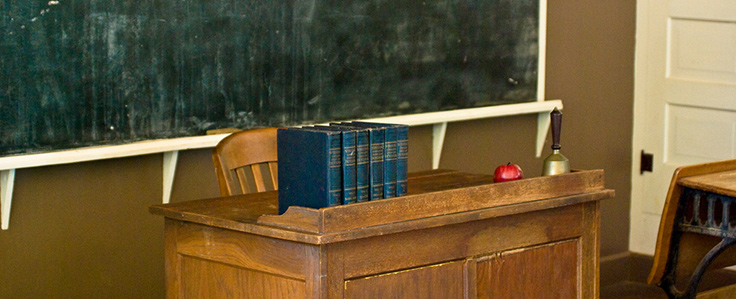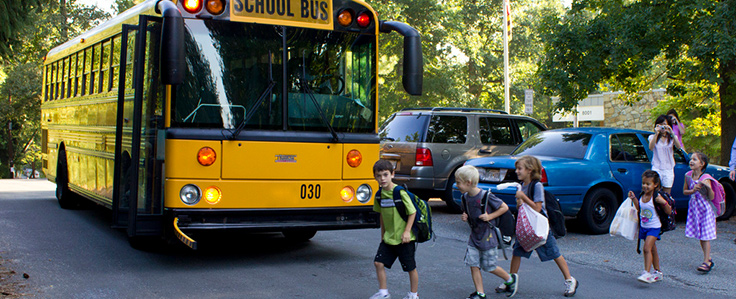Race to the Top: How Every State Stacks Up
As President Obama begins his second term in office, and we near the fourth anniversary of the Race to the Top program announcement, it’s time to check in and see how RttT is doing. This $4.35 billion Department of Education competition offered states millions in exchange for reforms in the education system. Nearly every state submitted an application, but only 11 states (Delaware, Florida, Georgia, Hawaii, Maryland, Massachusetts, New York, North Carolina, Ohio, Rhode Island, Tennessee) and the District of Columbia won funding in Phases 1 and 2. Planned RttT reforms include new standards and assessments, better data systems, enhanced teacher evaluation and support, and tough action to turn around low-performing schools in each state. Here’s a look at how states are doing — and where they’re headed — now that we’re just past the halfway mark of the program.
Saved by the Bell
Overall, the majority of the states in Race to the Top are doing well with their plans. They needed the cash, and they’re on schedule to implement their proposed plans and meet their goals. Although no state has made it through the process without hitting any hurdles, they are making great progress. Of the 12 states participating in Phase 1 and Phase 2 funding, eight — Massachusetts, Ohio, Delaware, North Carolina, Rhode Island, Maryland, Tennessee, and the District of Columbia — are all considered to be moving swiftly in the right direction.
Great Teachers and Leaders
A major goal of Race to the Top has been improving educator evaluation, attracting top teachers, and providing effective support for instruction with data systems and other measures. Several states have made exceptional progress in support and development of great teachers and leaders.
Delaware in particular has done exceptionally well in this department, with the Delaware Performance Appraisal System, which evaluates educators and provides resources for better rewarding and supporting teachers. Additionally, Delaware has increased teacher and principal recruitment by 150 new educators with alternative certification and new partnerships with programs including Teach for America and the Delaware Leadership Project. This is not surprising, as Delaware was one of the first two states to receive RttT funding, due in large part to its unanimous participation (with 100% of the state’s districts and teachers signed on), a new law on educator effectiveness, and financial incentives for distributing talent. In fact, U.S. Education Secretary Arne Duncan has praised Delaware for their good work so far, noting that the state has “been very aggressive” and that “the eyes of the nation are on Delaware,” positioning the state as a leader in the Race to the Top program, particularly when it comes to teachers and leaders.
Maryland is believed to be farther along than any other state with teaching Common Core Standards, thanks to Educator Effectiveness Academies held over the summer that informed teachers and principles from every state about the new learning progress benchmarks.
North Carolina has done particularly well with its professional development for educators, which has been well received, including a Summer Institute for local leadership teams and online professional development modules. North Carolina has also been able to accelerate its READY standards and assessment initiative thanks to the federal funds.
Rhode Island has made educator support a major part of their Race to the Top initiative, successfully beginning an induction program for all new teachers, launching a centralized system for evaluation tools, guidance, and data, and training almost 5,000 educators for the new Common Core State Standards.
Tennessee has done great work in attracting qualified educators, largely through high-quality alternative pathways. These include UTeach and Teach Tennessee, and they have proven to be excellent routes for attracting college graduates, particularly in subjects that are typically hard to staff, such as STEM and foreign languages.
In Washington, D.C., teacher and leader evaluations have been overhauled, to include multiple measures of performance, and steps to make student achievement a part of evaluation.
Low-Performing Schools
Turning around the lowest-achieving schools has been a controversial subject for Race to the Top, with critics like respected American education research professor Diane Ravitch speaking out against the program with comments including, “Closing schools is not a school improvement strategy.” But despite the drawbacks of this component of Race to the Top, several states are seeing progress in turning around low-performing schools, including Massachusetts, Ohio, D.C., and North Carolina.
Although D.C. had trouble with a high staff turnover in its Race to the Top office, the District has still initiated intervention models for 20 schools, with central intervention staff, vendors, and intervention support, becoming a leader in this Race to the Top initiative. Additionally, the District has committed to closing persistently low-performing charter schools. Interestingly, D.C. was able to work toward its goals with low-performing schools without using Race to the Top funds in Year 1, instead turning to other resources including philanthropic funding.
North Carolina is doing well in this measure, too, turning around schools that are performing in the lowest 5% of all schools nationwide, with many of them now reporting higher graduation and student performance rates.
Closing Achievement Gaps, Supporting the Transition to College and Career
Perhaps the most important part of Race to the Top, states are working to improve their hard numbers: making sure that students from all race and gender groups are achieving as equally as possible, and increasing the number of students who graduate and either go to college or continue in successful careers following high school. We haven’t seen many setbacks, and several states are reporting steady progress in these measures.
Ohio has seen progress among 8th graders in math and reading, but there’s still work to be done with the 4th grade level, which actually dropped in reading proficiency and showed no gains in math. Ohio has also done well in reducing the achievement gap between white and non-white students, particularly in the Hispanic gap. But the state has had trouble with students that have limited English proficiency, as their gap actually increased by about 7%. To support and encourage students to become college-bound, Ohio has adopted new common core standards that support college and career readiness.
D.C. has seen student proficiency in math increase, and the achievement gap among gender and race groups has become significantly smaller for all but a few select groups. The District has also successfully worked to support the transition to college and career-ready standards and high-quality assessments, as well as data systems to support and improve instruction.
Rhode Island has launched an innovative virtual-learning instruction resource for students who struggle with math, and it’s clearly paid off. The state has shown great progress in NAEP mathematics measures, both in 4th and 8th graders.
Tennessee has reported an impressive accomplishment: while other measures remain relatively steady, the achievement gap between children without disabilities and children with disabilities has closed dramatically, by about 13 percentage points, while most other states report gains or losses in the single digits.
The most impressive college readiness gain seen comes from Delaware, where they’ve worked hard to create better resources for college enrollment, offering 11th graders free access to the SAT. Thanks to this free access, the state was able to boost participation to 95% compared to the previous 36%.
Struggling to Stay in the Race
Although the majority of the states are seeing success with their Race to the Top program expectations, there are some states where initiatives haven’t yet worked out as expected. It seems that they have not yet been able to deliver, running into problems with teachers’ unionsn and difficulty issuing timely contracts, among other issues. Two states, Hawaii and Georgia, have been placed in “high risk” status, and two others, New York and Florida, have run into difficult roadblocks.
Hawaii has been placed in high risk status due to difficulties with its teacher and principal evaluations. The contract has not yet been approved, and has been mired in negotiations to tie evaluation decisions to salaries. However, despite this one hugely troublesome spot, the state has completed an amazing 90% of the tasks that were outlined in its grant contract. Hawaii has done particularly well in improving its data systems and implementing the Common Core State Standards.
Georgia is having a near-identical issue, with teacher evaluations causing a problem. Part of Georgia‘s Race to the Top grant has been put on high-risk status, and the state stands to lose about $33 million of its $400 million grant if it is unable to address concerns from the Department of Education. Georgia has made several amendments to its teacher evaluation plan, and the department is concerned that the state has strayed from its original vision that won them the grant. Still, like Hawaii, Georgia is overall demonstrating sufficient progress with the rest of its plan.
Although New York has not been put on high-risk status, the state is on a watch list because of slow progress. They’ve hit a roadblock with, once again, not yet adopting an educator evaluation system. The state has also had difficulty implementing a database to track student records across school districts. Beyond these issues, though, New York has shown significant progress. State Education Commissioner John King is “confident about the long-term direction” and remains “entirely optimistic that we’ll find a way forward” past the moments of disagreement.
Most experts are confident that Florida will succeed in meeting Race to the Top expectations, but the state is lagging behind schedule. The big problem: Florida is employing a large number of outside contractors, and negotiating contracts has proved to be time consuming. Of Florida’s $700 million grant, half of it, — $350 million — is going to contractors, and in all, the state will manage 48 different contracts. While working on these extensive contracts, though, Florida has still done great work, implementing school turnaround models in all of the state’s 71 persistently low-achieving schools and a locally negotiated teacher evaluation process in every Race to the Top district.
There are also disappointing spots among states that had a chance to win funds but ended up backing out of the competition. Days before the deadline, Texas Governor Rick Perry announced that Texas would halt months of work in preparing for the federal grant competition, backing out in protest. Perry said that the program is an intrusion on state control and that Texas “would be foolish and irresponsible to place our children’s future in the hands of unelected bureaucrats and special-interest groups thousands of miles away in Washington,” walking away from potentially $700 million in education funding. Alaska dropped out of the race as well, not wanting to “hand over authority,” according to Education Commissioner Larry LeDoux, who said that the program was a “bad fit for Alaska.” Virginia also withdrew, with Governor Robert McDowell citing the common standards imitative as the main reason for their departure. Virginia previously spent 15 years to create its own benchmarks, the Standards of Learning, which are believed to be superior to Common Core Standards, and the state was unwilling to retool them.
Nationwide Effects
Race to the Top has had a nationwide impact even beyond the states that ultimately won grants. In an effort to win funds through Race to the Top, many states instituted changes that would allow them to become more competitive. Most notably, 41 states adopted Common Core Standards. States changed their laws to allow value-added modeling in teacher evaluations. And states like Illinois lifted their caps on charter schools. As participating RttT states continue to fulfill their goals, we can expect to see the rest of the nation watching and considering how these changes may or may not work for their particular school systems.
What’s Next?
Although several states have made great progress, we’re only just past the halfway point of the Race to the Top program. It’s clear there’s still plenty of work to be done, even among top achieving states.
Maryland has plans to develop an online learning tool, STEMnet, designed to effectively deliver resources for science and math teachers. The state has also had trouble with creating a teacher evaluation system that is acceptable to both state officials and teachers. Similarly, North Carolina is working to launch improved virtual learning tools, with course offerings in math and science as well as an instructor recruiting system.
The U.S. Department of Education has commended Massachusetts for new curriculum guidelines that emphasize college and career readiness, as well as a new teacher evaluation program, and progress with several low-performing schools. This state is the shining star of the Race to the Top program, but there’s still room for improvement. Massachusetts has work to do in narrowing the student achievement gap, particularly in the female/male gap, and children without disabilities/children with disabilities gap, areas which showed the least improvement since RttT implementation.
Delaware struggles with achievement gaps in some measures as well, with a recent report still showing some gaps, particularly among students based on race and income.
Participating Race to the Top states are continuing to work hard to meet their grant expectations even as the program expands, introducing a Phase 3 state-level competition, an Early Learning Challenge, and most recently, a district-level race, open to individual school districts as well as charter schools. Although there’s more to come, progress is definitely being made. The race has begun; we just have to finish it.











